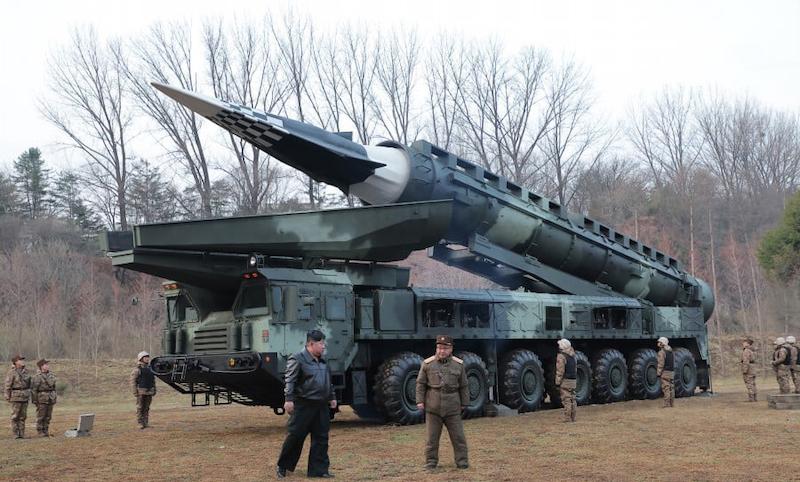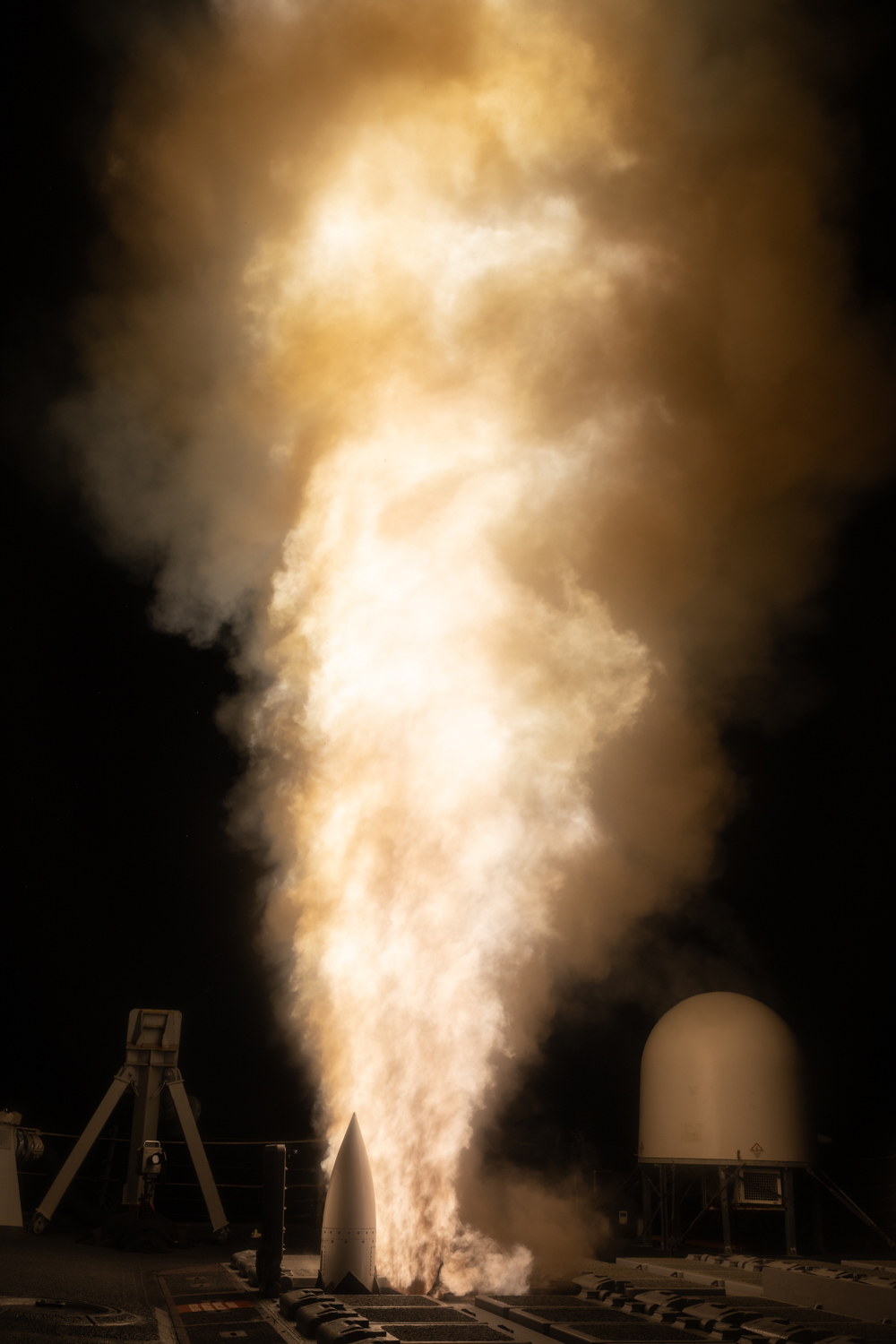
North Korea on Tuesday morning launched an intermediate-range ballistic missile (IRBM), known as the Hwasongpho-16B, and stated that it was a new type of “solid-fuelled ballistic missile loaded with newly developed hypersonic gliding warhead,” according to a state media report on Wednesday.
Tuesday’s launch was North Korea’s third ballistic-missile firing this year, with earlier launches in January and March. The test firing of the Hwasongpho-16B was carried out at an army training field on the outskirts of the North Korean capital of Pyongyang and overseen by North Korean leader Kim Jong Un, reported state media Korean Central News Agency , and was aimed at confirming the technical specifications of the missile and its reliability.
After the missile was launched, the hypersonic warhead separated from the missile and reached its first peak at a height of 101.1 km and the second at 72.3 km, while traveling 1,000 km before hitting its target in the East Sea (Sea of Japan). “The test-fire had no adverse effect on the security of neighboring countries,” reported KCNA.
Kim was satisfied with the firing and said the weapon was developed to demonstrate the advantage of North Korea’s defense science and technology. He also claimed that North Korea had successfully implemented the Party Central Committee’s three principles of building a missile-armed force for rapidly, accurately and powerfully striking any enemy target worldwide, according to KCNA.
Japan’s Ministry of Defense issued a statement on Tuesday saying that North Korea launched at least one ballistic missile from the west coast of North Korea toward the northeast at around 6:52 a.m. and that the missile flew 650 km at a maximum altitude of about 100 km and fell in the Sea of Japan east of the Korean Peninsula, outside Japan’s exclusive economic zone (EEZ).
According to the MOD, Minister of Defense Minoru Kihara had received instructions from Prime Minister Fumio Kishida to make every effort to collect and analyze information on the launch in close cooperation with the U.S., South Korea and other countries and to continue to ensure vigilance and surveillance in preparation for unforeseen circumstances. “North Korea’s series of actions, including its repeated launches of ballistic missiles, threaten the peace and security of Japan, the region, and the international community. Furthermore, such ballistic missile launches violate relevant Security Council resolutions and are a serious issue concerning national safety. Japan has strongly protested and strongly condemned North Korea,” reads the statement.
U.S. Indo-Pacific Command also issued a statement following the launch. “While we have assessed that this event does not pose an immediate threat to U.S. personnel, or territory, or to our allies, we continue to monitor the situation.The U.S. commitments to the defense of the ROK and Japan remain ironclad,” reads the statement.
South Korea’s Joint Chiefs of Staff (JCS) also issued a statement condemning North Korea’s IRBM firing. “We strongly condemn the North Korean missile launch as a clear act of provocation that gravely threatens the peace and stability of the Korean Peninsula,” reads the statement.
On Tuesday, the U.S., Japan and South Korea carried out a trilateral flight exercise, though it is unclear whether the exercise was already scheduled or in response to North Korea’s missile launch. According to a release, U.S. Air Force F-16s from the 80th Fighter Squadron, 8th Fighter Wing flew alongside Japan Air Self-Defense Force (JASDF) F-2s from the 8th Air Wing, and Republic of Korea Air Force (ROKAF) F-15Ks from the 11th Wing, escorting two U.S. Air Force B-52H Stratofortress Bombers. “The enhanced complexity and fluidity of our collective forces demonstrate the strength of the partnership and cooperation between the three countries, keeping with commitments made to regularize defensive exercise and increase readiness,” read the release.
A JASDF release on the flight said the exercise took place in the airspace northwest of the main island of Kyushu with the purpose of strengthening deterrence and response capabilities of the Japan-U.S. Alliance and advancing Japan-U.S.-South Korea trilateral security coordination. A South Korea Ministry of National Defense (MND) release echoed that the drills were conducted to improve deterrence and response capabilities to North Korea’s escalating nuclear and missile threats. “Going forward, the three countries will continue to expand trilateral exercises based on close coordination and strengthen cooperation to deter and jointly respond to the threat posed by North Korea,” concluded the release.

Meanwhile, the U.S. has been strengthening its ballistic-missile defense capabilities with its partners. A Missile Defense Agency release on Friday stated that on Thursday, the agency, in cooperation with the U.S. Navy, had successfully conducted an intercept of an advanced medium-range ballistic missile (MRBM) test target using the Standard Missile-6 (SM-6) Dual II with Software Upgrade (SWUP). Known as Flight Test Aegis Weapon System (FTM) 32, or Stellar Laelaps, the test demonstrated the capability to detect, track, engage and intercept an MRBM target in the terminal phase of flight culminating in a live intercept by an Aegis Baseline 9–equipped ship, according to the release, with Australian forces participating.
The test target was launched from the Pacific Missile Range Facility at Kauai, Hawaii. Destroyer USS Preble (DDG-88) launched the SM-6 Dual II missiles and successfully intercepted the MRBM test target, stated the release, which added that in addition, destroyer USS Jack H. Lucas (DDG-125), the first Flight III Aegis Destroyer equipped with SPY-6 radar, successfully participated in the event in support of its initial operational test and evaluation campaign.
Australia’s support included a demonstration of the radar capabilities of frigate HMAS Stuart (FFH153), together with a Royal Australian Air Force E-7 Wedgetail airborne early-warning and control (AEWC) aircraft assisting in data collection and communications. Australian sensors also provided target-track data in support of a cued-organic simulated engagement, demonstrating allied interoperability, according to the release.
On Tuesday the Missile Defense Agency issued a release stating that it had successfully demonstrated the first tracking of a live space object by the AN/SPY-7(V)1 solid-state radar integrated with the Aegis weapon system (AWS). The radar is to be installed on Japan’s Aegis system–equipped vessel (ASEV). The trial was also observed by the Japan Maritime Self-Defense Force (JMSDF) and a U.S. Navy Aegis technical representative. During the tracking event, which was performed at Lockheed Martin’s Production Test Center in Moorestown, New Jersey, the SPY-7 radar tactical hardware and software detected and tracked objects in space, and then passed data to the AWS for further processing, according to the release. The ASEVs are replacing the two canceled Aegis ashore sites and Japan expects to take delivery of the two destroyers in its FY2027 and FY2028 timeframe. Japan’s MOD issued a short statement on the success of the trial.





